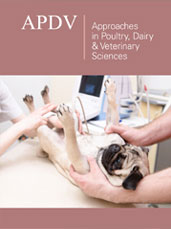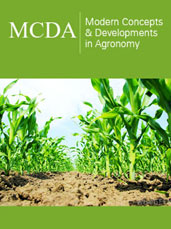- Submissions

Full Text
Approaches in Poultry, Dairy & Veterinary Sciences
Sero-Epidemiological Survey on Major Cattle Diseases in Awsiresu Zone of Afar Region
Amare Bihon1* and Getachew Derbew2
1School of Veterinary Medicine, Woldia University, Ethiopia
2College of Health Sciences, Woldia University, Ethiopia
*Corresponding author: Amare Bihon, School of Veterinary Medicine, Woldia University, Ethiopia
Submission: November 07, 2024;Published: February 25, 2025

ISSN: 2576-9162 Volume9 Issue5
Abstract
Ethiopia’s Afar region, crucial for its livestock-based economy, faces significant challenges due to cattle diseases impacting productivity and contributing to economic losses. This study evaluated local perceptions of cattle diseases, identified major health issues, and assessed their sero-prevalence in the Awsiresu zone. Using participatory epidemiological methods and serological testing, the research highlighted Contagious Bovine Pleuropneumonia (CBPP), ectoparasites, and Lumpy Skin Disease (LSD) as critical concerns. CBPP was prevalent in Asayita, Mille, and Dubti, while ectoparasites were most troublesome in Chifra. LSD affected cattle primarily between one and three years old. Serological results indicated an overall CBPP prevalence of 11.9%, with highest rates in Mille and lowest in Chifra, and a high Foot-and-Mouth Disease (FMD) prevalence of 77.6%. Gender and age did not significantly influence disease prevalence. The study underscores the need for targeted interventions such as vaccination and improved management practices, emphasizing community-based approaches for effective disease control and improved livestock productivity in the region
Keywords:Afar region; Cattle diseases; Ethiopia; Participatory epidemiology; Sero-prevalence
Introduction
Ethiopia’s agricultural sector, critical for both highlanders and lowlanders, is heavily reliant on livestock, but economic returns are undermined by diseases, poor management, and low genetic potential of indigenous breeds. These diseases negatively impact herd productivity through animal deaths, weight loss, slow growth, and poor fertility, leading to suboptimal outcomes [1-3]. In sub-Saharan Africa, livestock disease-related losses are estimated at about $2 billion annually, equally divided between direct mortality and indirect reductions in productivity [4]. In the Afar region, livestock production struggles due to declining pasture productivity caused by recurrent drought, land degradation, and other environmental stressors, which exacerbate disease prevalence and heighten poverty among pastoralists [5-8].
The limited and unreliable information on cattle diseases in Afar, due to accessibility and resource constraints, underscores the need for comprehensive data collection. A survey identified 19 major diseases, with ectoparasites, lumpy skin disease, CBPP, and anthrax being the most prevalent. Effective disease management requires both active and passive surveillance methods, including participatory appraisal (PA), which facilitates the collection of qualitative data and the development of targeted interventions [1,9,10]. Accurate and detailed data on disease types, prevalence, risk factors, and transmission are essential for designing effective preventive and control strategies, ultimately enhancing livestock health and productivity and contributing to poverty alleviation in the region [2,8-10].
Materials and Methods
Study area
The study was conducted in Awsirasu (Administrative Zone 1) in the Afar Region, Ethiopia. The area has a population of 410,790 and a density of 13.58 people/km². The population is primarily Afar (88.52%) and Amhara (9.97%), with Afar and Amharic as the main languages. The majorities (96.55%) are Muslim, and 43.47% are pastoralists. Key features include the Awash River, its tributaries, and a chain of six lakes [6].
Study population
The study targeted pastoralists and cattle in the Awsirasu zone.
Study Design, Sampling Strategies, and Sample Size Determination
A. Study Design: A cross-sectional survey using participatory
epidemiological techniques and a serological study was
conducted from June 2020 to February 2021.
B. Sampling Technique: Four districts (Chifra, Mile, Asayta, and
Dubti) were purposively selected for high cattle populations.
Two pastoral associations per district were chosen by lottery,
and two focus group discussions (FGDs) were conducted in
each, totaling 80 participants. For serological studies, 210
cattle were sampled.
C. Sample Size Determination: For diseases CBPP, LSD, and FMD,
sample size was calculated using Thrusfield’s formula with a
50% expected prevalence. The formula required 384 samples,
but 210 were collected.

D. Study Procedure and Methodology
E. Proportional Piling: Informants ranked ten cattle diseases
using 100 stones based on their impact, discussing clinical
signs and transmission.
F. Seasonal Calendar: Seasons were represented symbolically, and
informants used 100 stones to indicate disease occurrences.
G. Blood Sample Collection: 10ml of blood was collected from
the jugular vein, stored overnight for serum separation, and
analyzed at the National Veterinary Institute, Ethiopia. Data on
age, sex, and geo-reference were recorded.
H. Serological Identification: Standard tests used were c-ELISA
for CBPP, 3ABC ELISA for FMD, and Serum Neutralization Test
for LSD
Data Analysis
Participatory epidemiology data was entered to EPI INFO software and was exported to SPSS (version 23) computer program. Both analytical and descriptive statistics were used to analyze the data. Serological results were analyzed by using SPSS (version 20) computer program. The statistical tests like descriptive statistics and chi-square test of independence were used.
Result
District level prioritization of common cattle diseases
The survey revealed that CBPP was the priority disease in Asayita, Mille and Dubti districts while ectoparasites take the priority in Chifra district. furthermore, skin diseases (ectoparasites and LSD) were major concerns for cattle herders across the community. The table and key findings provide a clear overview of the primary and secondary diseases affecting cattle in these districts, highlighting the regional variations in disease prevalence and priority (Table 1).
Table 1:District level prioritization of common cattle diseases.

Zonal level prioritization of cattle diseases, seasonal occurrence and affected age groups
The prioritization of cattle diseases at the zonal level revealed that CBPP (Contagious Bovine Pleuropneumonia), ectoparasites, and LSD (Lumpy Skin Disease) were the top three concerns among cattle herders. Ectoparasite infestation and mastitis were identified as year-round issues. Age-specific disease prevalence showed that ectoparasites primarily affected calves under 6 months, while tuberculosis and mastitis were more common in cattle over 3 years. CBPP predominantly impacted animals below 1 year of age, peaking in March and April. These findings emphasize the need for tailored interventions, such as regular vaccination and veterinary care for CBPP, year-round ectoparasite control measures, and improved husbandry practices to manage mastitis. The results also highlight the importance of community-based approaches to enhance disease management and control in these regions (Table 2).
Table 2:Prioritization of cattle diseases, seasonal occurrence and affected age groups.

Clinical signs and transmission methods of prioritized diseases
The prioritized cattle diseases, as identified by FGD participants, exhibit distinct clinical signs and transmission methods (Table 3).
Table 3:Clinical signs and Transmission methods of prioritized diseases.

Description of explanatory variables
From a total of 210 animals 28.6% animals was from chifra district while assayita, mille and dubti contributing 23.8% of animals independently. Regarding with sex of animals, 84.3% of animals was females and 15.7% of animals were males. Moreover, 76.7% and 23.3% of animals was from adult and young age categories (Table 4).
Table 4:Description of explanatory variables.

Prevalence of CBPP with respect to associated risk factors
The overall prevalence of CBPP antibody was 11.9% in zone one of afar region in the study period. The highest prevalence rate was recorded from mille (28%) and the lowest was from Chifra (3.3) with a significant association between districts. Age and sex was insignificantly associated with prevalence of CBBP antibody (Table 5).
Table 5:Prevalence of CBPP with respect to associated risk factors.

Prevalence of FMDV with respect to associated risk factors
The overall prevalence of bovine FMD virus antibody was 77.6% in zone one of afar region in the study period. The highest prevalence rate was recorded from Dubti, Assayita, Mille and Chifra were 68%, 86.4%, 86.4% and 68.3% respectively and the association between woredas was significant (p<0.05%). The highest prevalence regarding sex and age were recorded in female (79.1%) and adult (78.9%) animals. Age and sex was insignificantly associated with prevalence of FMDV virus (Table 6).
Table 6:Prevalence of CBPP with respect to associated risk factors.

Discussions
District-level prioritization in the Afar region highlighted Contagious Bovine Pleuropneumonia (CBPP) as the top concern in Asayita, Mille, and Dubti. CBPP, caused by Mycoplasma mycoides subsp. mycoides, leads to severe respiratory disease and high cattle mortality, resulting in significant economic losses. This prioritization aligns with its documented impact in sub-Saharan Africa, where CBPP remains a major threat to cattle health and productivity [11,12]. Mariner et al. [11] reported high CBPP prevalence and significant economic losses in East Africa, emphasizing the need for effective vaccination and control measures. Schieck et al. [12] also highlighted the persistence of CBPP as a major issue in Kenya, reflecting similar challenges in the Afar region.
In Chifra, ectoparasitic diseases were prioritized due to their role as vectors for other diseases and their direct impact on cattle health. Ectoparasites like ticks, mites, and lice cause skin irritation and can transmit diseases such as anaplasmosis and babesiosis. Their prevalence is particularly high in warm climates, where they thrive and pose a significant challenge [13]. Gharbi & Darghouth [13] emphasized the importance of managing ectoparasites to prevent secondary infections and improve cattle health, while Walker et al (2003) detailed the effectiveness of various control strategies in reducing ectoparasite-related issues.
Lumpy Skin Disease (LSD), a viral disease characterized by skin nodules and associated with economic losses due to reduced milk production and weight gain, was a significant concern across all districts. LSD’s increasing prevalence in East Africa underscores the urgency of control measures [14,15]. Tuppurainen & Oura [14] documented the rising incidence of LSD and its impact on livestock, highlighting the need for effective vaccination and management strategies. Coetzer & Tuppurainen [14] similarly discussed the economic impact of LSD and recommended comprehensive control measures to mitigate its spread.
These district level CBPP, ecto-parasite and LSD findings underscore the importance of targeted disease management strategies, including vaccination, improved husbandry practices, and community-based approaches like focus group discussions, to address the specific challenges posed by CBPP, ectoparasitic diseases, and LSD [9,16].
Contagious Bovine Pleuropneumonia (CBPP), ectoparasites, and Lumpy Skin Disease (LSD) emerged as the top three prioritized cattle diseases at the zonal level. CBPP, a severe respiratory disease caused by Mycoplasma mycoides subsp. mycoides, primarily affects young cattle below one year of age, particularly in March and April. This disease causes significant economic losses due to high morbidity and mortality rates, and its impact on young cattle underscores the need for effective vaccination and control measures [11,12,17,18]. Ectoparasites, including ticks, lice, and mites, pose a year-round threat, predominantly affecting calves under six months. These parasites not only cause direct harm, such as anemia and skin irritation, but also serve as vectors for other diseases, necessitating consistent control efforts like regular acaricide treatments and improved pasture management [13,19- 21]. LSD, a viral disease spread by insect vectors, primarily affects cattle between one to three years old, leading to nodules on the skin and mucous membranes. Its seasonal peaks, aligning with increased vector activity, highlight the importance of vector control and vaccination to mitigate its impact [14-16,22,23]. Together, these diseases underscore the critical need for targeted interventions to improve cattle health and productivity in affected regions.
Regarding clinical signs and transmission methods explained by the respondents, Contagious Bovine Pleuropneumonia (CBPP), Ectoparasites, and Lumpy Skin Disease (LSD) are significant cattle diseases with distinct clinical signs and transmission methods. CBPP, caused by Mycoplasma mycoides subsp. mycoides, presents with cough, nasal discharge, fever, and rapid decline, often leading to death within days. It spreads primarily through direct contact with respiratory secretions from infected animals, making it highly contagious in crowded conditions. Effective control measures include vaccination, quarantine, and culling of infected animals [11,12,17,18]. Ectoparasites, such as ticks, lice, and mites, cause direct harm through blood-feeding, leading to anemia, hair loss, skin irritation, and secondary infections. They also act as vectors for diseases like anaplasmosis and babesiosis. Transmission occurs through direct contact and environmental vectors. Management strategies include regular acaricide use, pasture rotation, and maintaining overall herd health to reduce infestation [13,19,20,21]. LSD, caused by the Capripoxvirus, manifests as skin nodules, fever, and general malaise, and is primarily transmitted through insect vectors like mosquitoes and flies, as well as direct contact and contaminated equipment. Control involves vaccination, vector control, and quarantine measures during outbreaks to prevent spread [14-16,22,23].
The study revealed an overall CBPP antibody prevalence of 11.9% in Zone One of the Afar region, with notable differences between districts: Mille had a high prevalence of 28%, while Chifra had a much lower rate of 3.3%. This variation likely reflects differences in local cattle management, environmental conditions, and vaccination efforts. Mille’s higher prevalence might be due to less effective control measures or higher livestock density, while Chifra’s lower rate could be a result of better management or more effective vaccination programs. Interestingly, the study found that age and sex did not significantly affect CBPP prevalence, suggesting that these factors may be less important compared to other aspects like herd density and vaccination status. Similar trends have been observed in other studies, both in Ethiopia and internationally, where differences in CBPP prevalence are often linked to local practices and control measures [11,12,24,25]. While age has sometimes been associated with higher prevalence in other research, and sex rarely shows a significant impact, it’s clear that management practices and environmental factors play a more critical role in determining disease rates [11,12,25].
The study found a high overall prevalence of Foot-and-Mouth Disease Virus (FMDV) antibodies at 77.6% in Zone One of the Afar region, with significant district-level variations: Dubti, Asayita, Mille, and Chifra had prevalence rates ranging from 68% to 86.4%. This variability likely reflects differences in cattle management, vaccination coverage, and exposure levels. Although higher prevalence was observed in females (79.1%) and adults (78.9%), these differences were not statistically significant, suggesting that other factors, such as district-specific control measures and environmental conditions, play a more critical role. Similar regional variations in FMDV prevalence have been documented in Ethiopia and other countries, underscoring the importance of local management practices and vaccination strategies [1,10,25].
Conclusion and Recommendations
The study underscores the critical importance of addressing Contagious Bovine Pleuropneumonia (CBPP), ectoparasitic diseases, and Lumpy Skin Disease (LSD) in the Afar region, where these diseases significantly impact cattle health and productivity. CBPP emerged as the top concern in Asayita, Mille, and Dubti due to its severe respiratory effects and high mortality rates. Ectoparasitic diseases were identified as a major issue in Chifra, impacting cattle year-round and acting as vectors for other diseases. LSD was a widespread concern across all districts, causing notable economic losses through reduced milk production and weight gain. The study revealed a 77.6% prevalence of Foot-and-Mouth Disease Virus (FMDV) antibodies and significant variations in CBPP and FMDV prevalence between districts, reflecting differences in local management and vaccination efforts. Effective control and management strategies are essential to mitigate the impact of these diseases [26-33].
Recommendations
1. Enhanced Vaccination Programs: Implement
comprehensive and targeted vaccination campaigns for CBPP,
LSD, and FMDV. Focus on areas with high prevalence rates and
ensure vaccines are administered according to recommended
schedules.
2. Improved Disease Surveillance: Strengthen surveillance
systems to monitor and control the spread of CBPP, ectoparasites,
and LSD. Regular health checks and timely reporting of disease
outbreaks are crucial.
3. Ectoparasite Control: Develop and implement effective
ectoparasite management strategies, including regular use of
acaricides, improved pasture management, and vector control
measures. Educate farmers on the importance of parasite
control and integrated pest management.
4. Community Engagement: Use community-based
approaches, such as focus group discussions, to identify local
disease priorities and tailor interventions accordingly. Involve
local farmers in disease management and prevention efforts to
enhance the effectiveness of control measures.
5. Training and Capacity Building: Provide training for
veterinarians and livestock keepers on disease identification,
prevention, and management. Increase capacity for handling
and controlling outbreaks through workshops and educational
programs.
6. Research and Development: Support ongoing research
to develop more effective vaccines and treatments for CBPP,
LSD, and ectoparasitic diseases. Invest in studies to better
understand disease dynamics and improve control strategies.
7. Policy and Infrastructure Support: Advocate for policy
changes and infrastructure improvements to support livestock
health management. Ensure adequate funding and resources
are allocated for disease control programs and veterinary
services.
References
- Ayelet G, Gelaye E, Negussie H, Asmare K (2012) Study on the epidemiology of foot and mouth disease in Ethiopia. Rev Sci Tech 31(3): 789-798.
- Lebago R (2006) Challenges in livestock production and disease management in Ethiopia. Veterinary Parasitology 139(1): 47-59.
- Gizaw Y, Bekana M, Abayneh T (2007) Major reproductive health problems in smallholder dairy production in and around Nazareth town, Central Ethiopia. Priory Medical Journal Online 2.
- Haan C (1991) The economic impact of livestock diseases in sub-Saharan Africa. World Bank Technical Paper No 135.
- Joanne P, Asnake A, Kassaye H (2005) Livelihoods/Emergency assessment in Afar region. Oxfam International, Addis Ababa, Ethiopia.
- Abeba H (2014) Livestock population and their productivity in Awsiresu Zone of Afar Region, Ethiopia. Journal of Agricultural Science and Technology 14(3): 199-207.
- Asegid B (1991) Epidemiological study of major skin diseases of cattle in Southern Range Lands. FVM, AAU, DVM Thesis, Debre-Zeit, Ethiopia.
- Fentaw M (2021) Impact of environmental stressors on livestock health and productivity in East Africa. Journal of Environmental Management 295: 113075.
- Catley A, Okoth S, Osman J, et al. (2001) Participatory diagnosis of a chronic wasting disease in cattle in southern Sudan. Prev Vet Med 51(3-4): 161-181.
- Tadesse, S., et al. (2020). "Participatory appraisal and its application in livestock disease management in Ethiopia." African Journal of Animal Science, 17(1), 55-63.
- Mariner JC, McDermott J, Heesterbeek JAP, Thomson G, Martin SW (2006) A heterogeneous population model for contagious bovine pleuropneumonia transmission and control in pastoral communities of East Africa. Preventive Veterinary Medicine 73(1): 75-91.
- Schieck E, Liljander A, Hamsten C, Heller M, Salt J, et al. (2014) High antibody responses against contagious bovine pleuropneumonia in a cattle flock in Kenya detected using a recombinant protein-based ELISA. Transboundary and Emerging Diseases 61(6): 447-454.
- Gharbi M, Darghouth MA (2014) A review of the economic impact of tick infestation on livestock in Africa, The Middle East and Asia. Experimental and Applied Acarology 62(2): 273-282.
- Tuppurainen ESM, Oura CAL (2012) Review: Lumpy Skin Disease: An Emerging Threat to Europe, the Middle East and Asia. Transbound Emerg Dis 59(1): 40-48.
- Coetzer JAW, Tuppurainen ESM (2004) Lumpy skin disease. In: Infectious Diseases of Livestock 2nd (edn), Oxford University Press Southern Africa, Cape Town, South Africa, 2: 1268-1276.
- OIE (2017) Lumpy Skin Disease. In: Manual of diagnostic tests and vaccines for terrestrial animals 2017. World Organisation for Animal Health, Paris, France.
- Windsor RS (2000) Contagious bovine pleuropneumonia: The costs of control in Africa. Revue Scientifique et Technique (International Office of Epizootics) 19(1): 149-159.
- March JB (2004) Improved formulations for existing CBPP vaccines: Attempts to optimize their efficacy in cattle. Veterinary Microbiology 99(1): 63-74.
- Jonsson NN (2006) The productivity effects of cattle tick (Boophilus microplus) infestation on cattle, with particular reference to Bos indicus cattle and their crosses. Vet Parasitol 137(1-2): 1-10.
- Wall R, Shearer D (2001) Veterinary Entomology: Arthropod Ectoparasites of Veterinary Importance. Springer.
- FAO (2004) Ticks: Acaricide resistance: Diagnosis, management and prevention. Food and Agriculture Organization of the United Nations, Rome, USA.
- Weiss KE (2003) Lumpy skin disease virus. In: Virus Infections of Vertebrates: Virus Infections of Ruminants, Elsevier Science Publishers, Amsterdam, Netherlands, 3: 53-67.
- Ali AA, Esmat M, Attia H, Selim A, Abdel-Hamid YM (1990) Clinical and pathological studies of lumpy skin disease in Egypt. Vet Rec 127(22): 549-550.
- Kassa T, Mengistu A, Gashaw M (2020) Prevalence and associated risk factors of contagious bovine pleuropneumonia in southern Ethiopia. Journal of Veterinary Medicine and Animal Health 12(6): 167-175.
- Chenyambuga SW, Molla M, Moritz M (2012) Seroprevalence and risk factors associated with contagious bovine pleuropneumonia in Tanzania. Tropical Animal Health and Production 44(5): 1043-1050.
- Asegid T (1991) Constraints to livestock production in the Afar region of Ethiopia. Animal Production Research 17(2): 120-127.
- Amanfu W, Sediadie S, Masupu K, Raborokgwe MV, Benkirane A, et al. (2000) Comparison between c-ELISA and CFT in detecting antibodies to Mycoplasma mycoides mycoides biotype SC in cattle affected by CBPP in Botswana. Ann N Y Acad Sci 916: 364-369.
- Catley A, Alders RG, Wood JLN (2014) Participatory epidemiology: approaches, methods, experiences. Veterinary Journal 191(2): 151-160.
- Gizaw S (2007) The status of animal health services in Ethiopia. Tropical Animal Health and Production 39(5): 287-295.
- Haan CD, Bekure S (1991) Animal health services in sub-Saharan Africa: Initial experience with new approaches. ILCA ALPAN Network Paper.
- OIE (2010) Manual of Diagnostic Tests and Vaccines for Terrestrial Animals, Chapter 2.4.13. Lumpy Skin Disease, Paris, France.
- Radostits OM, Gay CC, Blood DC, et al. (2007) Veterinary Medicine- A text book of the diseases of Cattle, Sheep, Pigs, Goats and Horses, WB Saunders Co Ltd, London.
- Thrusfield M (2007) Veterinary Epidemiology. 3rd (edn), LTD Blackwell Science, Burgh, UK, pp. 182-189.
© 2025 Amare Bihon. This is an open access article distributed under the terms of the Creative Commons Attribution License , which permits unrestricted use, distribution, and build upon your work non-commercially.
 a Creative Commons Attribution 4.0 International License. Based on a work at www.crimsonpublishers.com.
Best viewed in
a Creative Commons Attribution 4.0 International License. Based on a work at www.crimsonpublishers.com.
Best viewed in 







.jpg)






























 Editorial Board Registrations
Editorial Board Registrations Submit your Article
Submit your Article Refer a Friend
Refer a Friend Advertise With Us
Advertise With Us
.jpg)






.jpg)














.bmp)
.jpg)
.png)
.jpg)










.jpg)






.png)

.png)



.png)






